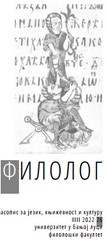ЛЕКСИЧЕСКОЕ СВОЕОБРАЗИЕ СЕРБСКИХ ГОВОРОВ ЮГО-ВОСТОЧНОЙ ГЕРЦЕГОВИНЫ
LEXICAL PECULIARITY OF SERBIAN DIALECTS OF SOUTHEASTERN HERZEGOVINA
Author(s): Ekaterina YakushkinaSubject(s): Regional Geography, Phonetics / Phonology, Lexis, South Slavic Languages
Published by: Филолошки факултет Универзитета у Бањој Луци
Keywords: Serbian language; dialectological lexicology; Slavic linguogeography; Serbian dialects in Bosnia and Herzegovina;
Summary/Abstract: This article is a part of a large study of the linguistic and geographical features of Serbian vocabulary, carried out by the author of this article on the basis of dialect questionnaire materials specially collected for this purpose in 2019-2021. In order to identify the arealogical characteristics of Serbian vocabulary and identify isoglosses passing through the territory of Serbian dialects, in conversations with dialect speakers from various regions of Serbia, Bosnia and Herzegovina and Montenegro, and in some cases personally by dialect speakers, questionnaires were filled out based on lexical questions of the Serbo-Croatian Dialect Atlas. The article describes the lexical features of the dialects of two settlements located in southeastern Herzegovina – Ljubinje and Djedići (In addition to the Herzegovina villages described in the work, material from another 20 Serbian settlements in Bosnia and Herzegovina and Serbia, as well as several Croatian ones, is involved in the analysis.). The article highlights the following characteristics of Southeast Herzegoviаn vocabulary: 1) the preservation of Proto-Slavic archaisms, characteristic of the peripheral areas of the Central Slavic area; 2) the use of words characteristic of the west of the Central Slavic area and uncharacteristic of its eastern part; 3) the use of words characteristic of the regions near the Adriatic coast; 4) the widespread use of lexical doublets, namely the use of words with different areal characteristics in the dialect. Based on the comparison of questionnaires from Ljubinje and Djedići with questionnaires from other researched points, we can distinguish several types of areas, which include south-eastern Herzegovina. 1) the south-western area; 2) the east Herzegovian area: unity with the dialect of the village of Mosorovići; 3) the western area; 4) the peripheral (in the broad sense of the word, including the dialects west of Drina and the dialects of (south) eastern Serbia); 5) Bosnian-Slavonian 6) eastern (uniting the dialects of eastern Herzegovina, Bosnia and Serbia). Typical, however, is the case of overlapping, or interference, of the western and eastern or central and peripheral areas.
Journal: Филолог – часопис за језик, књижевност и културу
- Issue Year: 13/2022
- Issue No: 26
- Page Range: 40-50
- Page Count: 11
- Language: Russian

